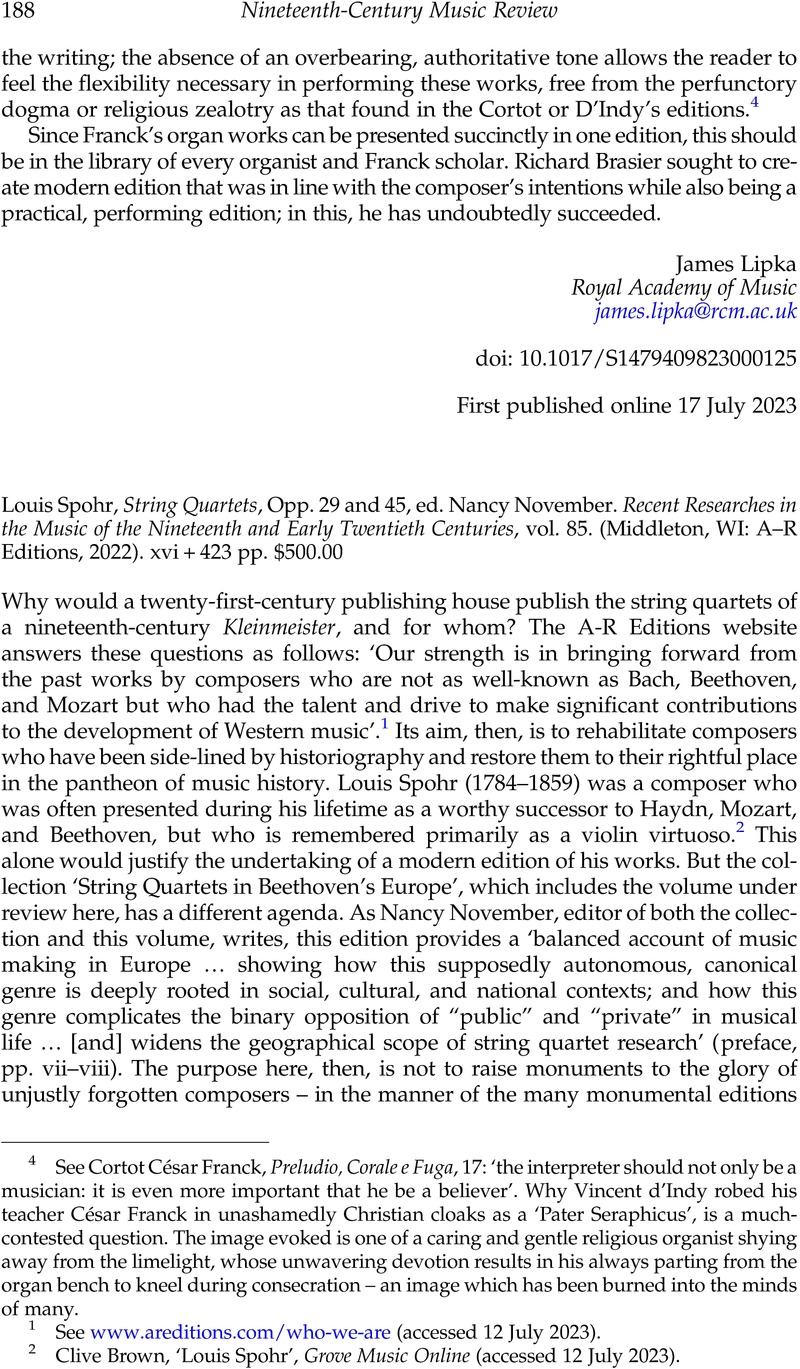No CrossRef data available.
Article contents
Louis Spohr, String Quartets, Opp. 29 and 45, ed. Nancy November. Recent Researches in the Music of the Nineteenth and Early Twentieth Centuries, vol. 85. (Middleton, WI: A–R Editions, 2022). xvi + 423 pp. $500.00
Review products
Published online by Cambridge University Press: 08 September 2023
Abstract

- Type
- Score Review
- Information
- Nineteenth-Century Music Review , Volume 21 , Special Issue 1: Clara Schumann: Changing Identities and Legacies , April 2024 , pp. 188 - 194
- Copyright
- Copyright © The Author(s), 2023. Published by Cambridge University Press
References
1 See www.areditions.com/who-we-are (accessed 12 July 2023).
2 Clive Brown, ‘Louis Spohr’, Grove Music Online (accessed 12 July 2023).
3 For instance, see Bashford, Christina, ‘Historiography and Invisible Musics: Domestic Chamber Music in Nineteenth-Century Britain’, Journal of the American Musicological Society 63 (2010): 291–360CrossRefGoogle Scholar; Louise Bernard de Raymond, Les quatuors à cordes ‘viennois’ et ‘parisiens’ d'Antoine Reicha: édition critique et étude stylistique (PhD diss., Sorbonne Université, 2013); Louise Bernard de Raymond, ‘En immersion dans la culture du quatuor à cordes du début du xixe siècle avec Antoine Reicha’, Antonín Rejcha znovunalezený: katalog výstavy / Antoine Reicha redécouvert: catalogue de l'exposition, ed. Jana Franková et François-Pierre Goy (Brno: Moravská zemská knihovna, 2021), 252–306; Fauquet, Joël-Marie, Les Sociétés de musique de chambre à Paris de la Restauration à 1870, (Paris: Aux amateurs de livres, 1986)Google Scholar; Klorman, Edward, Mozart's Music of Friends: Social Interplay in the Chamber Works (Cambridge: Cambridge University Press, 2016)CrossRefGoogle Scholar; Janet M. Levy, The ‘Quatuor Concertant’ in Paris in the Latter Half of the Eighteenth Century (PhD diss., Stanford University, 1971); Morabito, Fabio, ‘Rehearsing the Social: Beethoven's Late Quartets in Paris, 1825–1829’, The Journal of Musicology 37 (2020): 349–82CrossRefGoogle Scholar; Lott, Marie Sumner, The Social Worlds of Nineteenth-Century Chamber Music: Composers, Consumers, Communities (Urbana: University of Illinois Press, 2018)Google Scholar; and The String Quartet from the Private to the Public Sphere, ed Christian Speck (Turnhout: Brepols, 2016).
4 November, Nancy, ed., String Quartets in Beethoven's Europe (Boston: Academic Studies Press, 2022)CrossRefGoogle Scholar.
5 November, Nancy, Beethoven's Theatrical Quartets, Opp. 59, 74 and 95 (Cambridge: Cambridge University Press, 2013)Google Scholar. She has continued her work on the quartet genre in the early nineteenth century with two monographs on quartet culture in Beethoven's time: November, Nancy, Cultivating String Quartets in Beethoven's Vienna (Woodbridge: Boydell Press, 2017)Google Scholar, and Beethoven's Symphonies arranged for the Chamber, Sociability, Reception, and Canon Formation (Cambridge: Cambridge University Press, 2021).
6 Ward, Michael B. and Morabito, Fabio, ‘Texture as Structure: Concerto Elements in the String Quartets by Rodolphe Kreutzer, Pierre Rode and Antoine Reicha’, in Antoine Reicha and the Making of the Nineteenth-Century Composer, ed. Morabito, Fabio and Bernard, Louise de Raymond (Bologna: Ut Orpheus, 2021): 27Google Scholar.
7 DeNora, Tia, Beethoven and the Construction of Genius: Musical Politics in Vienna, 1792–1803 (Berkley: University of California Press, 1995), 60–82CrossRefGoogle Scholar.
8 Brown, ‘Louis Spohr’.
9 Fabio Morabito and Louise Bernard de Raymond, ‘The Composer as Process’, in Antoine Reicha and the Making of the Nineteenth-Century Composer, ed. Fabio Morabito and Louise Bernard de Raymond (Bologna: Ut Orpheus, 2021): xv.
10 The secondary theme of the first movement of Op. 45 No. 2 is an exemplary expression of the waltz topic (bars 41–84). In addition to the 6/4 time signature and the melody in the first violin part, it is the rhythm of three quarter notes followed by a dotted minim in the cello part that evokes the 6-beat units characteristic of the basic waltz step. See McKee, Eric, Decorum of the Minuet, Delirium of the Waltz. A Study of Dance-Music Relations in ¾ Time (Bloomington: Indiana University Press, 2012), 12Google Scholar.
11 McKee, Decorum of the Minuet, 3–4.
12 An exception is the recent paper by Erica Buurman in which she looked at Beethoven's late quartets through this lens, ‘Beethoven and the Deutsche: Dance Types and Popular Melodies from the Ritterballett to the Late Quartets’, paper delivered at the Internationaler Kongress der Gesellschaft für Musikforschung / International Congress of the Society for Music Research, 28 September 2021.
13 Buurman, Erica, The Viennese Ballroom in the Age of Beethoven (Cambridge: Cambridge University Press, 2022), 5CrossRefGoogle Scholar.
14 November, Beethoven's Theatrical Quartets, 12.
15 The accompanying rhythm (minim plus crochet rest in the cello, with quaver rest and five quavers in the second violin and viola parts) is somewhat less characteristic of the waltz topic than in the first movement of Op. 45 No. 2.
16 Louis Spohr's Autobiography, Translated from the German (London: Longman, Green, Roberts, 1865): 191–2. On the balls held during the Congress of Vienna, see Buurman, The Viennese Ballroom in the Age of Beethoven, 148–69.
17 In the ideology of early nineteenth-century German-speaking writers, the string quartet was associated with the miniature paintings displayed in the cabinets of aristocrats (while the symphony was associated with the painting of panoramas). The metaphor emphasized both the refinement and richness of detail required to write a quartet and a private, elitist listening practice. See November, Nancy, ‘Theater Piece and Cabinetstück: Nineteenth-Century Visual Ideologies of the String Quartet’, Music in Art 29 (2004): 135–50Google Scholar.
18 McKee, Decorum of the Minuet, 11–12.
19 Horton, Julian, ‘Listening to Topics in the Nineteenth Century’, in The Oxford Handbook of Topic Theory, ed. Mirka, Danuta (Oxford: Oxford University Press, 2014): 642Google Scholar.
20 Brown, Clive, Classical and Romantic Performing Practice 1750–1900 (Oxford, Oxford University Press, 2002)Google Scholar.
21 Southon, Nicolas, ‘Une science des textes musicaux : l’édition critique de partitions. Histoire et principes généraux. Situation de la musique française’, Histoire de la recherche contemporaine 7/1 (2018): 31–2Google Scholar.
22 Brown, Clive, ed., Selected Works of Louis Spohr 1784–1859: A Ten-Volume Collection of Facsimiles, Reprints, and New Manuscript Scores, vol. 9 (New York: Garland, 1988)Google Scholar.
23 The 1828 Haslinger edition can be downloaded from International Music Score Library Project (IMSLP); see https://imslp.org.





